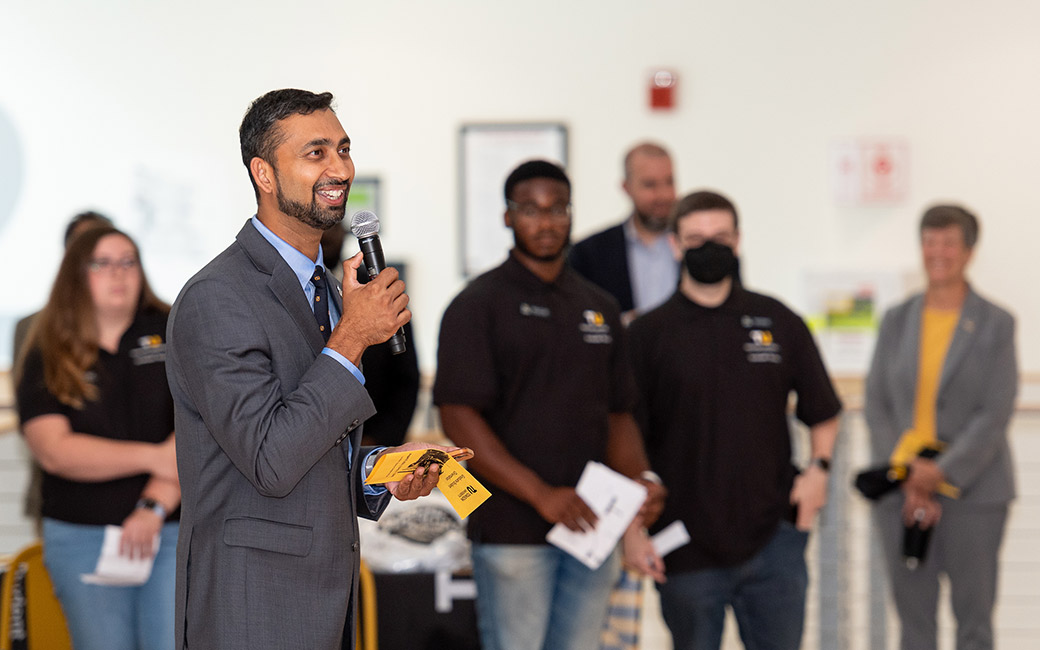TU to R2: The evolution to high research activity
Q&A with Sidd Kaza, associate provost for research and dean of graduate studies
By Bethany Pace

As TU seeks a designation as a high research activity institution, the journey to achieve this is a natural evolution as an anchor institution and nationally-recognized leader in inclusive excellence. From its inception as a college preparing teachers for the state of Maryland, TU has always adapted to fill the needs of a global economy.
Sidd Kaza became the university’s inaugural associate provost for research and dean of graduate studies on July 5 after serving as the chairperson of the Department of Computer and Information Sciences in TU's Fisher College of Science and Mathematics since 2016.
In his new position, Kaza will advance the transformative influence that research will play in students’ lives. He will work to inspire faculty and students to create a productive research environment that furthers TU’s impact as an anchor institution for our region and state and achieves the Carnegie Classification R2: High Research Activity institution.
We’ve recently had a chance to talk with him to learn more about what TU’s journey to R2 will look like and what it will mean to the community.
Why has TU prioritized research?
As a university, we don’t just deliver knowledge and solutions, we must create them as well. Research allows our faculty and students to remain cutting-edge in our disciplines, and pursue solutions for the public good. Research also fosters cultural understanding and critical thinking that are important for the interdependent world.
More importantly, involving our undergraduate and graduate students in research allows us to increase learning outside the classroom. More research projects and expenditures will also increase student jobs, facilitate interdisciplinary learning, and make our students even more prepared for the current workforce.
What is the Carnegie Classification?
The Carnegie Classification tool is used by researchers, policymakers and administrators, as well as for informing grant-making and federal and state funding of institutions. It was initiated in 1973 by the Carnegie Commission on Higher Education.
Simply put, it is a way to identify universities by the types of degrees awarded and has several categories, with three focused on research (R1, R2 and Doctoral/Professional University).
How often are Carnegie Classifications determined?
Classification updates are completed every three years. The 2021 update classified just under 3,900 institutions. The next classification update will occur in 2024, and then 2027.
What is TU’s current classification?
Towson University’s current Carnegie Classification is Master’s Colleges & Universities: Larger Programs (or M1) awarding over 50 master’s degrees per year. At TU we awarded over 900 master’s degrees and about 30 research and professional doctorates in 2021. Our focus to achieve the R2 classification centers around research doctorates.
How will TU earn the R2 Carnegie Classification?
R2 universities have “high research activity,” which means they award at least 20 research (as opposed to professional) doctoral degrees annually and have at least $5 million in total research expenditures. This funding can come from a combination of external sources and institutional investments including support for students. These criteria are subject to change—so we are aiming higher.
How will R2 attainment further TU’s reputation for excellent teaching experiences?
In addition to having high research activity, R2 universities also hold high value for professors’ roles as educators first.
At TU, this means that most courses will continue to be taught by professors who are involved in research. The institution’s emphasis on research will create additional and more robust opportunities for student researchers to participate in highly engaged learning experiences both in the classroom and outside it.
Why is the R2 designation important (both externally and to the university community)?
The R2 (or high research activity) designation emphasizes that TU faculty also perform research at world-class levels while furthering the university’s mission. It allows our students to get involved in a new kind of research-based learning, opening different opportunities for them. The university will have increased funding opportunities (from grants and the state) for faculty, staff and students. We will continue to serve our region’s needs not just through our academic programs but with research on topics that matter to our students and our community.
What’s next?
We want to take R2 a step further and ensure that we not only achieve it but also represent a well-positioned research institution: in graduate programs and undergraduate programs, and increasing the interaction between our student populations. TU will strive to become an R2 that supports research with a focus on making an impact.
Our investment in research will add yet another exciting dimension to the student experience at Towson University!
RESEARCH SUCCESS AT TOWSON UNIVERSITY
The Journey to R2
Towson University’s academic environment fosters multidisciplinary research and scholarship that breaks new ground, complements current knowledge and leads to superior teaching. From election security to uncovering local history, our research programs involve undergraduates, graduate students, faculty, the community, government and the private sector. Learn more.